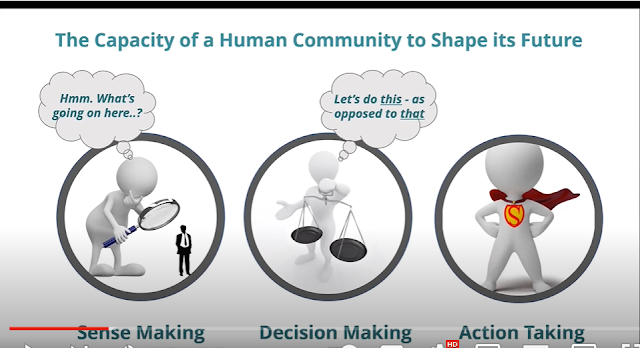Sense Making of Weak Signals for Organizational Adaptability & Performance Enhancement
Objective: To leverage sense-making methodologies in identifying weak signals within our organization’s operating model and the broader external environment. This approach aims to proactively detect and act upon emerging change opportunities, thus enhancing our adaptability and business performance.

- Why Sense Making and Weak Signals are Critical:
- Anticipate Changes: In today’s volatile and unpredictable business landscape, it’s crucial to foresee changes before they become disruptive.
- Strategic Advantage: Detecting weak signals allows organizations to pivot or adjust strategies, staying ahead of competitors.
- Continual Improvement: Recognizing inefficiencies within the current operating model can lead to innovations and improvements.
- What We’re Looking For:
- Internal Signals: Subtle inconsistencies or changes within organizational processes, employee feedback, and performance metrics that indicate areas for improvement.
- External Signals: Emerging market trends, shifts in consumer behavior, nascent technologies, and geopolitical changes that could impact the industry.
- How We’ll Do It:
- Data Collection & Analysis: Implement tools to gather both qualitative and quantitative data. Utilize analytics to interpret this information, looking for patterns and outliers.
- Engage Stakeholders: Foster a culture where every team member feels empowered to voice observations or concerns. This is vital for capturing ground-level insights.
- Scenario Planning: Based on detected signals, create various scenarios to anticipate potential futures. This aids in strategic decision-making.
- Feedback Loops: Establish feedback mechanisms to continually refine our sense-making processes.
- Collaboration with External Entities: Partner with market researchers, industry experts, and think tanks to gain a broader understanding of the external environment.
- Change Making:
- Informed Action: Once a weak signal is identified and validated, it will be matched with strategic initiatives. These initiatives will be driven by evidence-based decision-making processes.
- Adaptive Structures: Design our organizational structure in a manner that is agile and can rapidly pivot in response to identified weak signals.
- Continuous Learning: Encourage a culture of lifelong learning, ensuring our team remains equipped to understand and act on emerging trends and signals.
- Change Making:
- Informed Action: Once a weak signal is identified and validated, it will be matched with strategic initiatives. These initiatives will be driven by evidence-based decision-making processes.
- Adaptive Structures: Design our organizational structure in a manner that is agile and can rapidly pivot in response to identified weak signals.
- Continuous Learning: Encourage a culture of lifelong learning, ensuring our team remains equipped to understand and act on emerging trends and signals.

Conclusion: Embracing a sense-making approach in identifying and acting upon weak signals is essential for our organization’s adaptability and long-term success. By maintaining a vigilant stance towards both internal and external changes, we position ourselves to not just react, but proactively shape our future in a manner that maximizes business performance.
Emerging Technologies in Decision Intelligence: The Role of Generative AI
Introduction: Generative AI, often represented by models like OpenAI’s GPT and DALL·E, is at the forefront of the latest wave of artificial intelligence advancements. When considering decision intelligence, which is the discipline of turning data into better decisions, Generative AI can serve as a potent tool to augment human intelligence. Here’s how:
- Data Synthesis and Simulation:
- Scenario Generation: Generative AI can create numerous simulated scenarios or data sets, enabling organizations to test various hypotheses or strategies.
- Risk Management: By producing a multitude of potential outcomes and scenarios, businesses can anticipate potential pitfalls or challenges.
- Enhanced Data Interpretation:
- Pattern Recognition: While traditional analytics tools can identify patterns in structured data, Generative AI can find connections across broader data sets, including unstructured data.
- Predictive Analysis: Beyond just recognizing patterns, Generative AI can anticipate future trends based on historical and current data, enhancing forecasting accuracy.
- Content Generation and Knowledge Sharing:
- Automated Reporting: Generative AI can synthesize vast amounts of information into concise, human-readable reports, making it easier for decision-makers to understand data.
- Knowledge Expansion: Generative models can produce content or ideas based on existing knowledge, aiding in brainstorming and idea generation processes.
- Augmenting Decision Making:
- Decision Support: By processing vast amounts of information at high speeds, Generative AI can present recommendations or options to human decision-makers.
- Bias Reduction: If trained and calibrated correctly, AI can help highlight human biases in decision-making processes, leading to more objective decisions.
- Enhancing Creativity and Innovation:
- Idea Generation: Generative AI can come up with novel solutions or perspectives based on the input data, helping human teams think outside the box.
- Prototyping: In fields like design or product development, Generative AI can quickly produce multiple prototypes or designs, speeding up the innovation process.
- Personalization and Contextual Understanding:
- Tailored Interactions: Generative AI can customize content, recommendations, or solutions based on individual user data, ensuring more relevance in decision-support tools.
- Context Comprehension: By understanding the nuances of a given context, Generative AI can provide more relevant insights or predictions.
- Continuous Learning and Evolution:
- Adaptive Algorithms: Generative AI models can evolve over time, ensuring that they remain relevant and effective in changing environments.
- Feedback Integration: As more data becomes available or as feedback is provided, these models can refine their outputs, leading to improved decision intelligence over time.
Conclusion: Generative AI is reshaping the way organizations approach decision intelligence. By augmenting human intelligence, these models offer a symbiotic relationship where machines handle vast data and complex simulations, while humans bring contextual understanding, emotional intelligence, and ethics into the decision-making process. The combination promises more informed, efficient, and innovative decisions in diverse sectors.
